The first serial helicopter Nikolai Kamov
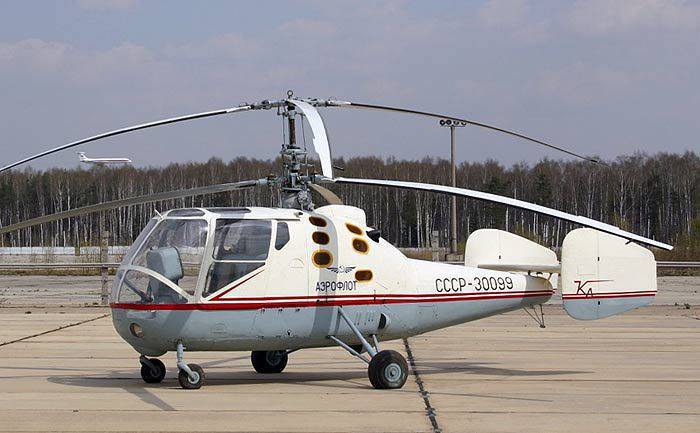
The Ka-15 was the first Kamov Design Bureau helicopter to be launched in a large series. This rotorcraft was originally developed for the needs of the marine aviation, as an anti-submarine helicopter, ship reconnaissance and liaison officer. It was the Ka-15 that became the first full-time helicopter on the ships of the Soviet Navy.
Today, some aviation enthusiasts sometimes ask themselves: "Why did our sailors prefer the coaxial rotorcraft scheme that was unfinished at that time? They preferred the usual single-rotor helicopter with tail rotor? Why did you have to take such a high technical risk?" Indeed, after all, even earlier, thanks to the successes of the venerable aviation designer I.I. Sikorsky in the United States, a helicopter with a tail rotor has already begun to be used in a wide variety of areas of human activity, including in the naval navy.
It should be noted that the production of tail rotor helicopters began on an unprecedented scale. American helicopter designer A. Young in the first half of the forties only in the United States counted more than 340 firms involved in the design and construction of helicopters of this scheme. In the late fifties in our country, in the ASB Design Bureau. Yakovlev and M.L. Mile, on a competitive basis, built single-rotor helicopters, respectively Yak-100 and GM-1 (in the series - Mi-1) with a maximum take-off mass of about 2500 kg. Preference was given to the Mi-1, which was built in a large series. However, for service in the domestic Navy, he did not fit. Why so?
The answer is quite simple. In the US, helicopters in the fleet began to be used on aircraft carriers. There were no problems with the placement, maintenance of takeoffs and landing of helicopters of the classical scheme on large ships. In the USSR, which did not have similar ships at that time, the use of helicopters in the Navy was planned to begin on ships of small displacements. These ships could be equipped with small-sized landing sites (VPPL), bordered by already existing ship superstructures, which significantly limited the approaches to them when performing flights.
Meanwhile, in OKB N.I. Kamov already had some experience creating coaxial helicopters. With the release and fine-tuning of the first ultralight ship single-seater helicopters of the coaxial scheme Ka-10 and Ka-10M, the formation of a young design bureau was completed. Troop tests of the Ka-10 lightweight conducted on the Black Sea revealed the need for a more heavy-lift and more independent helicopter for the Navy. Such a machine was the Ka-15, a multi-purpose helicopter designed also according to the coaxial scheme chosen by Kamov.
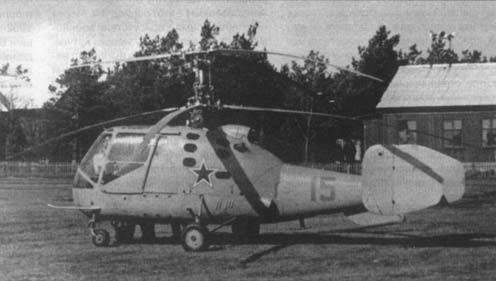
The new helicopter was a two-seater, in the cabin of which the operator’s seat was located to the right of the pilot. Ships of small displacement, as is known, are subject to a significant amount of rolling and pitching. The powerful turbulent air flow, the presence of various superstructures and the ship’s rolling motion caused distrust among our sailors of a helicopter with a tail rotor sensitive to wind speed and direction.
In order to finally be convinced that they were right, they even conducted comparative tests of the coaxial Ka-15 and single-rotor Mi-1 on the Mikhail Kutuzov artillery cruiser. Due to its minimum size and higher maneuverability, the coaxial Ka-15 successfully took off from a small runway and landed on it even at six-point sea state. Under these conditions, the Mi-1 with a long tail boom and tail rotor, which significantly limited the possibilities of its operation, could not be operated with the existence of high turbulence in the air flow and the vehicle carrier’s heave. Thus, the coaxial scheme of the helicopter in the USSR was claimed by the Navy.
It must be said that the coaxial scheme of rotary-winged cars attracted attention with its obvious advantages not only of domestic sailors, but also designers of the whole world. Almost all the power of the power plant is used to create thrust rotors. In addition, the jet moments created by the screws are mutually balanced in the main gearbox and are not transferred to the aircraft fuselage. All efforts and moments of forces from the helicopter’s carrier system are closed in the short fuselage compartment, located between two power frames, on which is located the gearbox and carrier system on top, and the chassis is mounted on the bottom, on both sides. A more compact scheme for the rotary-wing apparatus is almost impossible to create. That is why many well-known foreign aircraft designers, such as L. Breguet, D. Perry, S. Hiller, G. Berliner, A. Ascanio and others, as well as aviation companies, including the Russian ASB design bureau. Yakovlev, tried to master the coaxial scheme of the helicopter. In the number of 40s built in the second half, according to this principle, we can call the “Roteron”, “Brantly B-1”, “Benlix K”, “Dorand G-20”, Bell “Molel 49”, “Breguet G-11” -E "and" Breguet G-111 ", as well as the experimental helicopter of the Yakovlev Design Bureau.
Some of the helicopters created in 40-50-ies, for example, "Breguet G-111" (France), Bell "Molel 49" (USA) and others had excellent performance characteristics for that period. However, all foreign campaigns and the Yakovlev Design Bureau refused to improve and develop this promising scheme due to the large number of problems encountered.
The Kamov Design Bureau during the development, construction, testing and development work of the Ka-15 also encountered a number of difficulties due to the lack of a scientific and experimental base in the field of aeromechanics of coaxial rotors. Designers and scientists OKB successfully coped with many problems. Under the leadership of Nikolay Kamov, a unique school of scientific design and practical design of rotary-wing vehicles of various schemes, and, first of all, a coaxial scheme, was formed. Another problem that designers always encounter when designing new cars is the correct choice of the dimensions of the aircraft.
Chief Designer Kamov believed that after the Ka-10 with a take-off weight of less than 400 kg, the new Ka-15 helicopter, weighing 1500 kg, would most suit a wide range of conflicting interests. Apparently, at the time he was internally ready to design the helicopter in a heavier weight class. Kamov's comrades tried to convince him that the Mi-1 helicopter already existed in this class, which filled the niche in the interests of the military department and the national economy, and the Ka-15 would have a very narrow naval scope of application. In 1951, on the instructions of the government, Mil Design Bureau began the development of a Mi-4 helicopter with an take-off weight of 7000-8000 kg, which was mass-produced in 1952-m. Convince Kamov then failed. In this regard, his design bureau lost pace and the ability to take a leading position in the country in the number of serially produced helicopters with the cipher "Ka" in the class of rotary-wing vehicles up to 10000 kg.
The protection of the outline design of the Ka-15 took place in the 1951 year. In December, a full-scale model of the car was built. The first helicopter take-off took place in April 1953 of the year. Serial production of the helicopter was launched at the aircraft plant in Ulan-Ude in 1956 year.
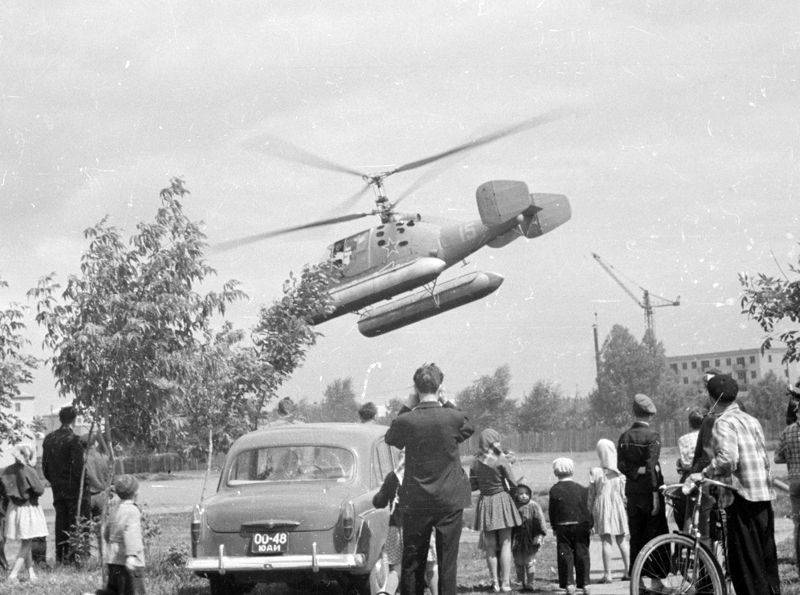
Let's compare the basic data of coaxial and single-rotor helicopters. From the above data, it follows that coaxial Ka-15 with half the engine power carries cargo of approximately the same mass in the cargo compartment as the famous single-rotor Mi-1, on which world records were set at 30. At the same time, the Ka-15 on the 1000 kg is lighter, and its length, taking into account rotating screws, is shorter than that of the Mi-1 by almost 1,7 times. It was these indisputable advantages of the compact Ka-15, combined with the highest maneuverability, that enabled the helicopter to successfully accomplish the main mission: successfully reconnaissance of the surface situation and ensure communication between ships and coastal bases in the interests of the Navy.
Even on the Ka-10, the coaxial rotor scheme and control system were brought to practical implementation. It included two skew automatons, general and differential pitch mechanisms, and a number of other elements. Of course, all this had to be improved during the finalization of the new helicopter. The joint operation of the engine and main rotors was combined by a control system, which in the cockpit had a command step-gas lever with a rotating knob to correct the engine's operating mode.
By the way, such a system was absent on the GM-1 helicopter from Milevskiy, and it was very difficult to control the machine in flight. With a common lever, the pilot changed the angles of installation of the rotor blades, and with the engine control lever (RUD) he selected the necessary mode of engine operation. Mil introduced this system later, already on a modification of the GM-1 helicopter, which received the designation Mi-1.
One of the most difficult tasks that designers had to solve was the study of the nature of vibrations on a coaxial helicopter and the development of recommendations and methods for bringing them to an acceptable level. To reduce the impact of external aerodynamic periodic forces, as early as 1947, enthusiasts led by Kamov, when building the first coaxial Ka-8 helicopter, developed a static and dynamic adjustment of the carrier system. During the bench and factory tests of the Ka-15, in collaboration with TsAGI and LII, a number of its design modifications were made, aimed at overcoming the self-oscillations of the earth resonance and the flutter of rotor blades. The combination of some constructive measures allowed to successfully cope with the problem of resonance on the Ka-15. Another no less dangerous type of auto-oscillations was the flutter of propeller blades in flight, which the OKB experts discovered in Ka-15 in 1953 year. Eliminated it by mounting on the blade counterweights of the original horn type, shifting its center forward by the required amount.
However, the operation of the helicopter in a humid sea climate soon gave an unexpected surprise: the flutter again began to give signals about itself in flight. It turned out that during operation, the swelling of the blades of the wood and the accumulation of moisture in the space of the compartments between the upper and lower skins occur. This led to a shift of centering back and caused the appearance of flutter. Soon, it was possible to detect the phenomena of flutter due to the shift of the centering of the blade back not from its swelling, but as a result of repairs carried out under the conditions of the operating units. To prevent the occurrence of self-oscillations of propeller blades, a standardized margin of centering efficiency was introduced into the technology for their creation. He allowed to finally take control of the rotor blade blades.
After launching the Ka-15 into the series, the scope of work to increase the service life of the machines and expand the possibilities of their use has changed significantly. Numerous stands for testing assemblies and the most loaded parts under dynamic stress conditions were put into operation at the plant. Continued long life tests. Flight studies were carried out to study the "vortex ring" and to work out recommendations to the pilot to prevent the helicopter from getting into this phenomenon and how to get out of it. The tests of the Ka-15 on the autorotation mode of the screws of the carrier system, including the implementation of landings on the airfield and water surface (with balloon chassis) with non-operating engines, were completed.
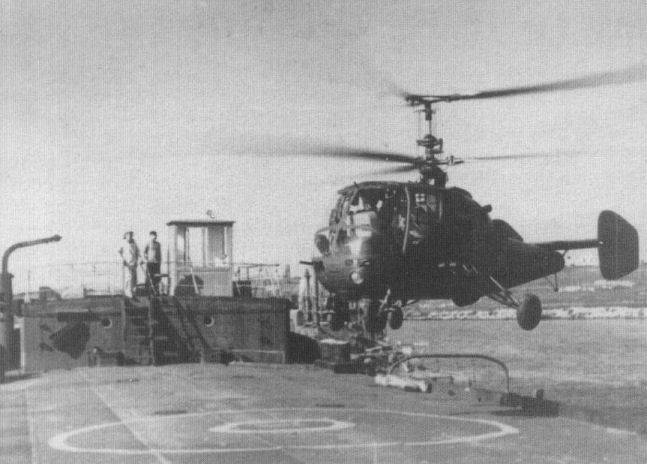
Marine trials of the ship's helicopter began in the 1956 year, in the Baltic, from the bases on board the destroyer Svetly. In 1957-1958, the first divisions of the Ka-15 were created. In 1958, the equipment of the Svetlyi VLPl destroyer began, and in 1961, the fleet was replenished with eight rocket ships of the 57 project with WFPl, tanks for aviation fuels and lubricants, cabins for aviators, and special equipment to support the operation of helicopters.
In the national economy, the Ka-15 was used as a scout for sea animals on ships of the trawling fleet. In the antisubmarine version, the Ka-15 could carry two radio-hydroacoustic buoys RGB-N or the SPARU receiver. In this case, a pair of helicopters worked together: one dropped buoys in the working square of the water area, and the other auditioned them using SPARU to detect a submarine, and to destroy it, the Ka-15 was used in a shock version, equipped with an OPB-1Р sight and equipped with two deep-seated bombs weighing 50 kg.
The Ka-15M variant had improvements to improve the kinematics of the control of the carrier system, increasing the reliability of the apparatus and the effectiveness of its operational adaptability. The Ka-15M was used in various versions and had the appropriate equipment: spraying, pollination, aerosol generation devices, special suspension containers for delivering mail and small cargo, rescue boats, removable side gondolas for transporting bed patients and much more.
Training UK-15 was required for pilot training and training flights. He had dual control, as well as additional flight equipment and curtains to perform training and training instrument flights. They built a helicopter in 1956 year at an aircraft factory in Ulan-Ude. In 1957, it successfully passed state tests and then was mass-produced. In total, the “fifteenth” 354 built copies of various modifications.
Ka-18 - further modification of the Ka-15M. It was intended for the transport of passengers, mail and cargo, for the transportation of the sick and injured to inpatient medical institutions. Along with Ka-15M, it was also used in aerial chemical work. The test machine was manufactured in 1956, and in 1957 it successfully passed the state tests. The Ka-18 was mass-produced, and was in service about 20 years. It was built over 110 machines.
From the base Ka-15, the civilian Ka-18 differed in an oversized cabin that accommodates a pilot, three passengers, or one patient on a stretcher and an accompanying medic. For the convenience of loading into the helicopter sanitary stretcher a hatch in the nose fairing of the fuselage is made.
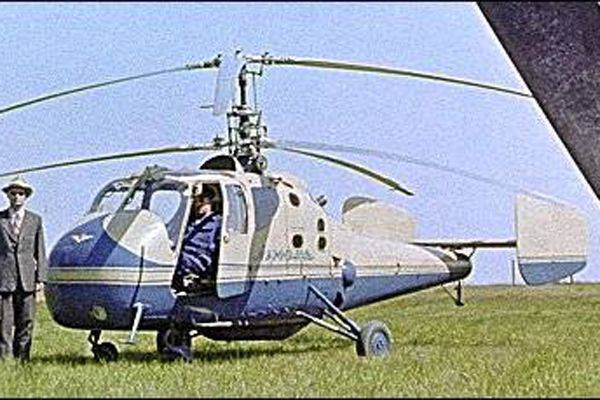
Under the leadership of Kamov in 1958-1963, a group of designers, technologists and scientists for the first time in the world created, tested and put into mass production the blades of the innovative design of polymer composites, they increased the aerodynamic quality of the rotors and significantly increased the life of the blades. Comparative tests of 11 sets of conventional wooden blades LD-10М and 6 of sets of new B-7 fiberglass blades were carried out on the electro-screw stand of the Design Bureau under the same conditions. At the same time, the polarity of the rotors with blades of the B-7 blades was almost the same, while the screws with the wooden blades showed a significant scatter.
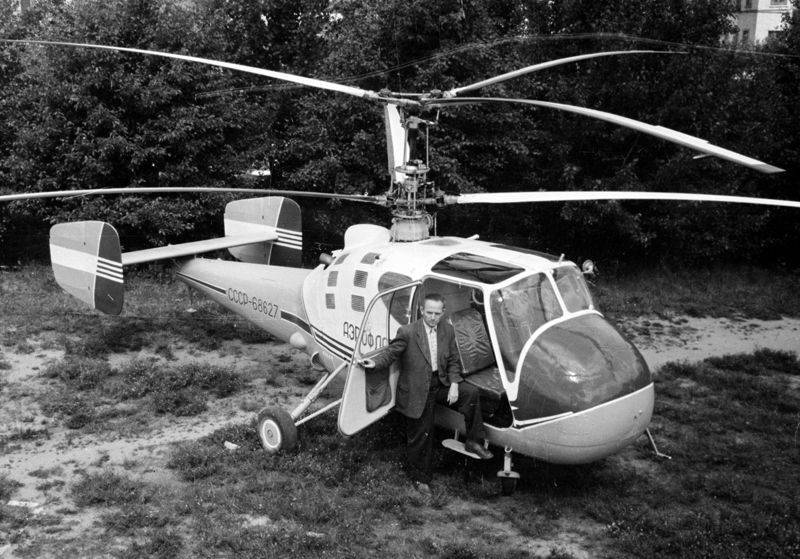
The design and manufacturing technology of the blades of polymer composites were patented in five, leading in the field of helicopter manufacturing, foreign countries. They served as the basis for the creation of more advanced blades of the new generation of propellers. Test pilot V. Vinitsky in the 1958-1959 years set two world speed records on the Ka-15M. And in 1958, at the World Exhibition in Brussels, Ka-18 received a gold medal. Nevertheless, a great merit in this belongs to the base Ka-15, on which all systems were previously developed, which made it possible to succeed on the Ka-18.
It was with the Ka- "fifteenth" that the wide practical operation of coaxial-rotor helicopters in the Navy and the Civil Air Fleet began.
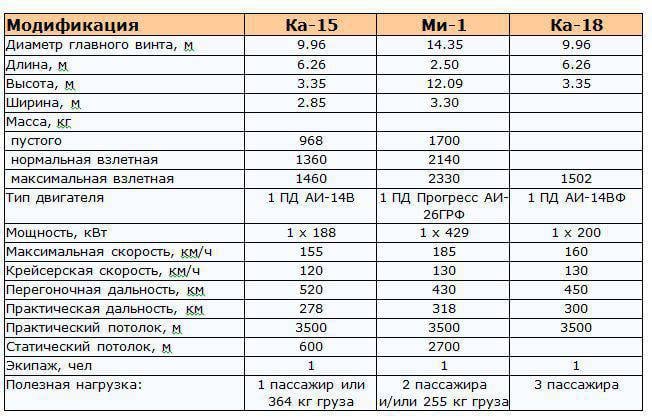
Sources:
Barshevsky K. Ka-15 - a multi-purpose ship helicopter // Planes of the world. 1996. No.5-6. C. 31-36.
Kuznetsov K. Firstborn coaxial scheme // Wings of the Motherland. 2000. No.11. C.11-14.
Artemyev A. Ka-15 opens the way to the ships // Wings of the Motherland. 2002. No.5. C.14-17.
Yakubovich N. On the instructions of the fleet // Wings of the Motherland. 2002. No.5. C.12-14.
Artemyev. A. Hunters for submarines // Aviation and Cosmonautics. 1996. No.7. C.42-43.
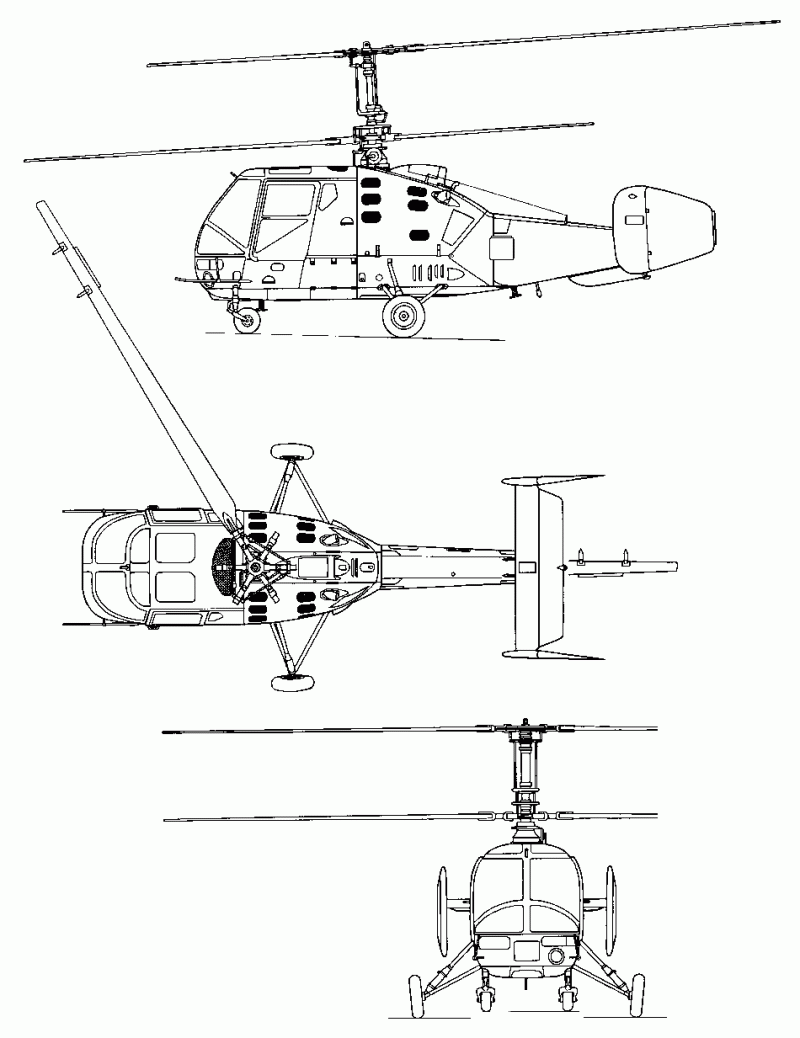
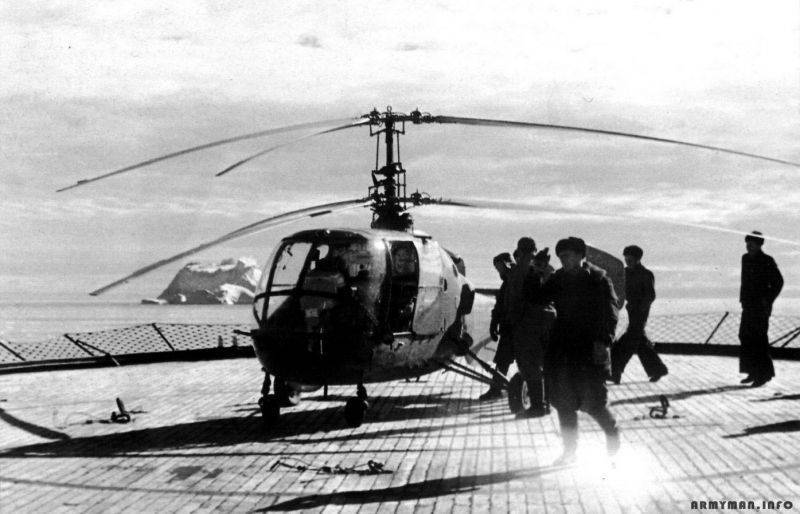
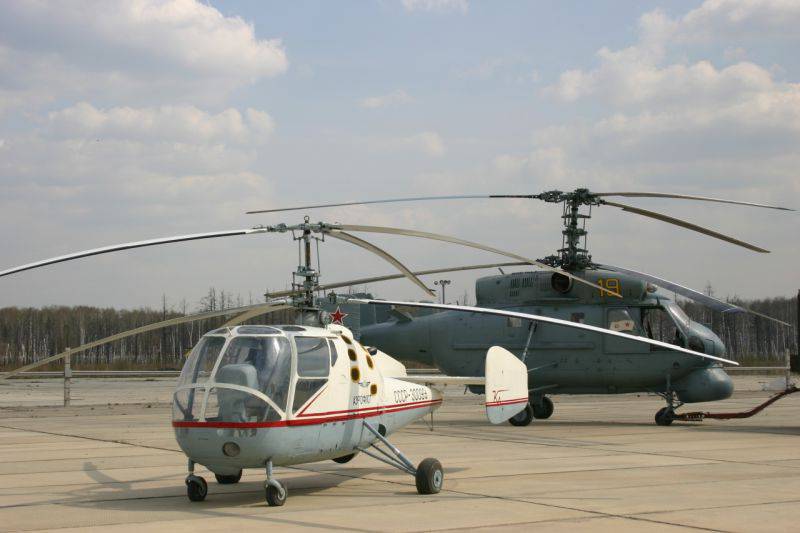
Information